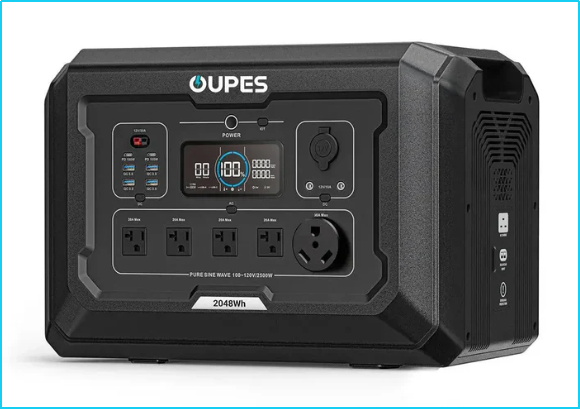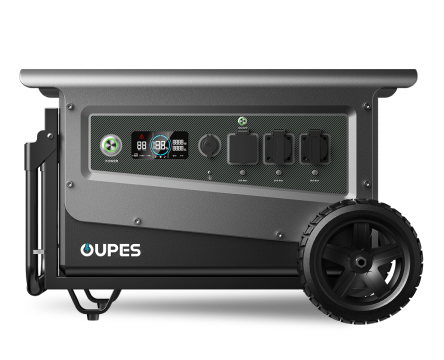
Overview
A solar power inverter is a crucial component in any solar energy system. It converts the direct current (DC) generated by solar panels into alternating current (AC) usable by common household appliances. Without an inverter, solar energy cannot power most devices people rely on daily. Whether used in rooftop systems, portable solar generators, or off-grid cabins, inverters play an essential role in energy conversion, safety, and system efficiency.
This guide provides an expert overview of how solar inverters work, different types available, performance considerations, and how they integrate with portable power stations. The information follows authoritative references from the U.S. Department of Energy (DOE), National Renewable Energy Laboratory (NREL), and solar engineering standards.
What Is a Solar Power Inverter?
A solar power inverter is an electronic device that converts DC (direct current) electricity from solar panels into AC (alternating current) electricity. Since nearly all homes and appliances in North America and Europe operate on AC power (120V–240V), inverters are indispensable in solar power setups.
Why Is an Inverter Necessary?
- Solar panels generate DC power, which most devices cannot use directly.
- Inverters stabilize voltage and frequency for safe appliance operation.
- Modern inverters include MPPT (maximum power point tracking) for higher panel efficiency.
- Inverters allow solar systems to work with batteries and portable power stations.
How a Solar Power Inverter Works
The working principle of an inverter can be summarized in three steps:
1. DC Input Collection
Solar panels produce a varying DC voltage depending on sunlight. The inverter collects this current and regulates it to maintain optimal energy conversion.
2. DC-to-AC Conversion
Using semiconductor switches such as IGBTs or MOSFETs, the inverter rapidly switches DC on and off, simulating an AC sine wave. This wave is filtered and stabilized to match grid standards.
3. Voltage Regulation and Output
The inverter ensures the AC output maintains a consistent frequency (50Hz or 60Hz) and voltage (120V or 230V), allowing appliances to function safely and efficiently.
Efficiency Considerations
According to NREL studies, modern inverters achieve 95–99% efficiency. High efficiency reduces energy loss and increases the usable power from solar panels or battery banks.
Types of Solar Power Inverters
1. String Inverters
These are traditional inverters used for roof-mounted solar systems. Multiple panels are connected in series to a single inverter. While cost-effective, string inverters can suffer from reduced performance if one panel is shaded.
2. Microinverters
Microinverters sit behind each panel and convert DC to AC at the panel level. This improves efficiency and shading tolerance but increases cost.
3. Hybrid Inverters
Hybrid inverters support both solar panels and battery storage systems. They are common in off-grid and backup power setups.
4. Pure Sine Wave Inverters
Pure sine wave inverters deliver stable, high-quality AC output suitable for sensitive electronics. They are the preferred inverter type used in portable solar generators and power stations.
5. Modified Sine Wave Inverters
These are cheaper alternatives but produce lower-quality power, which can cause noise or damage in sensitive appliances.
Solar Power Inverters vs. Solar Generators
Solar power inverters and solar generators are related but not identical. A solar generator is a complete system that typically includes:
- Solar power inverter
- Battery storage
- Solar charge controller
- Multiple AC/DC outputs
The table below highlights key differences:
| Feature | Solar Power Inverter | Solar Generator / Portable Power Station |
|---|---|---|
| Main Function | DC-to-AC conversion | Complete off-grid power solution |
| Includes Battery? | No | Yes |
| Includes Charge Controller? | No | Yes |
| Portability | Typically stationary | Portable and compact |
| Use Case | Home and commercial solar systems | Camping, RV, outdoor, emergency backup |
For most users looking for mobility, ease of use, and integrated safety features, a portable solar generator is the more complete solution.
How to Choose the Right Solar Inverter
1. Determine Power Requirements
The inverter’s rated output (e.g., 1000W, 2000W, 4000W) must match or exceed the wattage of the appliances you plan to power. Refrigerators, heaters, microwaves, and pumps require higher wattage.
2. Check Surge Capacity
Many appliances draw additional startup wattage—sometimes 2–3× their running power. Ensure the inverter can handle surge loads.
3. Choose Pure Sine Wave for Sensitive Electronics
According to DOE electrical standards, pure sine wave inverters are safest for laptops, medical equipment, and communication devices.
4. Consider Efficiency Ratings
Higher efficiency inverters reduce energy loss and extend the usable battery capacity in portable systems.
5. Match Voltage and Battery Type
Ensure compatibility with:
- 12V, 24V, or 48V battery banks
- LiFePO4 or AGM batteries
- MC4 solar connectors (for panels)
6. Safety Certifications
Look for UL, FCC, CE, or ETL certifications to ensure compliance with global safety standards.
Solar Inverters in Portable Power Stations (e.g., OUPES)
Portable power stations—sometimes called solar generators—embed advanced pure sine wave inverters that make them suitable for a broad range of off-grid applications. Brands like OUPES integrate high-efficiency inverters with LiFePO4 battery storage, solar charge controllers, and multiple output options.
How They Work Together
- The solar panels charge internal LiFePO4 batteries.
- The inverter converts stored DC power to AC output.
- MPPT controllers optimize solar charging efficiency.
This all-in-one design eliminates the need for users to buy separate components and assemble complex wiring. It is ideal for camping, RV travel, outdoor work, and emergency preparedness.
Common Use Cases for Solar Power Inverters
1. Off-Grid Cabins
Hybrid inverters power off-grid homes by converting solar energy from battery banks into usable electricity. Backup generators may be used as secondary support during winter.
2. RV and Van Life
RVers often use pure sine wave inverters to run:
- Microwaves
- TVs
- Laptops
- Water pumps
- Coffee makers
Portable solar generators with built-in inverters are especially popular in RV setups due to their plug-and-play design.
3. Emergency Home Backup
Inverters in portable power stations ensure uninterrupted power for medical devices, communication equipment, and refrigeration during outages—something the DOE emphasizes in its disaster preparedness guidelines.
4. Outdoor Worksites
Construction tools, LED work lights, and measurement devices often require AC power. Portable inverters allow workers to operate efficiently without relying on noisy fuel generators.
FAQ
1. Do solar panels always need an inverter?
Yes, if you want to power AC devices. However, DC-powered devices can run without an inverter if voltage matches.
2. Can I connect any inverter to a battery?
No. Voltage compatibility (12V, 24V, or 48V) and battery chemistry compatibility must match.
3. What size inverter do I need for home backup?
A 2000W–4000W pure sine wave inverter can power essential appliances like refrigerators, fans, lights, and electronics.
4. Are modified sine wave inverters safe?
They work for simple tools but are not safe for laptops, CPAP machines, induction cookers, or modern electronics.
5. Can solar inverters work during a power outage?
Standard grid-tied inverters shut off for safety. Hybrid inverters or solar generators continue to operate independently.
6. What inverter do portable power stations use?
Most use pure sine wave inverters for stable, clean output, making them suitable for sensitive electronics.




























